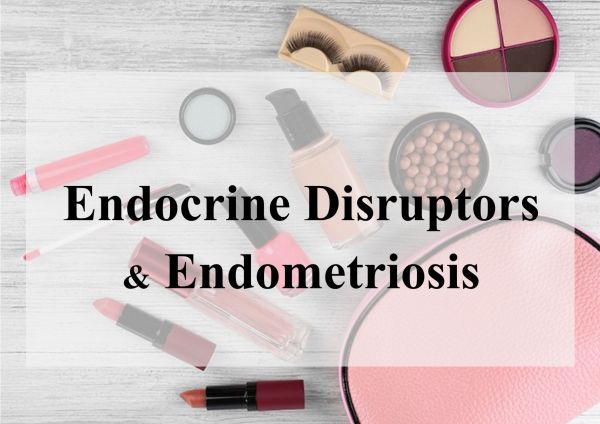Reduce exposure to endocrine disruptors to help endometriosis

Endometriosis and high estrogen levels often go hand in hand and exposure to endocrine disruptors just makes matters worse. An endocrine disruptor is basically a chemical compound that interferes with the normal functioning of the endocrine system and the reproductive and other biological processes regulated by it.(1)
There are many compounds in the environment that can mimic estrogen and are known to be powerful endocrine disruptors. These compounds can have an adverse effect on those with endometriosis causing a worsening of symptoms. Because they mimic the hormone estrogen this can lead to estrogen dominance and may increase the development of endometriosis.
Endocrine disruptors have the impact of hormone-mimicking chemicals on our cells, organs and metabolism. Commonly referred to as Endocrine Disrupting Chemicals, these toxic compounds closely resemble the estrogen that our bodies produce. They are commonly known as ‘xenoestrogens ’.
Xenoestrogens bind to estrogen-receptor sites on our cells and can disrupt the natural balance of hormones. They are very commonly found in household cleaners, toiletries and cosmetics. The pervasiveness of xenoestrogens in our environment makes them hard to avoid and leads to high levels of estrogen in the body.
Xenoestrogens that we absorb from our environment, food and personal care products must also be filtered by the liver. Many of these toxic substances cause damage to the liver in the process of being metabolised.
Symptoms of high estrogen in women:
- Weight gain — especially around the hips, waist and thighs
- Depression and anxiety
- Trouble sleeping
- Poor memory and difficulty concentrating
- Fatigue
- Mood swings
- Hair loss
- Irregular periods and PMS
- Fibrocystic breasts and uterine fibroids
- Loss of sex drive
- Swollen and tender breasts
- Bloating
- Endometriosis
- PCOS
- Cancer of the breast and uterus
Reducing your exposure to endocrine disrupting chemicals
To balance your hormones and reduce your exposure to these chemicals you need to change to using more natural chemical free products. As mentioned earlier, exposure to these chemicals can be a big burden on your liver and it is your liver that works to excrete toxins and chemicals from your body – so your liver is under extra stress.
Common sources of endocrine disruptors include:
- Plastics
- Pesticides
- Fertilisers
- Heavy Metals
- Personal Care Products
- Household Cleaners
- Prescription Hormones
- Hormones in Animal Products
- Aluminium foil
- Non-stick pans
- Drinking water

How to reduce exposure to chemicals
To reduce your exposure to these chemicals and decrease the damage they can cause, especially when dealing with endometriosis there are certain measures you can take.
Change products - change to organic chemical free toiletries and cosmetics
Safer cleaners - change to safer less toxic household cleaners
Eat organic raised meats – preferable white meats only
Use a water filter for your water consumption
Do not put hot food into plastic containers – this leeches’ toxins from the plastic into the food
Detox your liver – Milk Thistle - Studies have shown that milk thistle reduces liver injury caused by the use of over the counter medicines
Use castor oil packs to support and detox your liver. Castor oil packs promote healing by enhancing the flow of lymph and reducing inflammation. Castor oil packs directly support the liver by increasing our production of glutathione, lowering cholesterol levels and improving liver enzymes
Supplement with DIM - DIM converts dangerous estrogens into weaker, less cancer causing estrogens. It also reduces the effect of estrogen on cells.
Supplement with NAC - N-acetyl cysteine, better known as NAC is a common dietary supplement that supports liver health and prevents the development of cancers caused by high levels of estrogen
Supplement with Vitex - Vitex supports a healthy hormonal balance in women by stimulating the production of progesterone. Supporting progesterone remedies imbalances caused by unopposed estrogen, reduces the symptoms of PMS and perimenopause and prevents miscarriages caused by luteal phase defect
Supplement with Dandelion - Dandelion has a long history of use as a liver tonic in herbal medicine. Dandelion is rich in two kinds of potent antioxidants: beta carotene and polyphenols. Beta carotene protects us from cellular damage and oxidative stress while polyphenols decrease inflammation throughout the body
Supplement with licorice - It supports a healthy gut by restoring the protective lining of the digestive tract and soothing inflammation.
Supplement with magnesium - It is vital to over 600 bodily processes and necessary for the proper function of numerous endocrine glands including the thyroid, adrenals and pancreas. Magnesium is especially important for elimination of excess estrogens. The liver requires magnesium for the second phase of estrogen detoxification Low levels of magnesium inhibit this function and contribute to excess estrogen.
This is just a brief summary of the effects of endocrine disruptors and the measure you can take to reduce your exposure.
I have received feedback from other endometriosis sufferers who have changed to using natural toiletries and household cleaners and it really has made a difference to their symptoms.
Adding the use of detoxing supplements will help your system to cope better with any unwanted chemicals and supporting your liver is vital to keep your detox pathways working better.
You can find some recipes for home-made toiletries and using essential oils for beauty here
Reference:
(1) From Oxford Dictionary
https://www.ncbi.nlm.nih.gov/pubmed/25540137
https://www.thieme-connect.com/products/ejournals/abstract/10.1055/s-0032-1327831
https://www.ncbi.nlm.nih.gov/pmc/articles/PMC2900421/
https://www.researchgate.net/publication/308759333_Endocrine_Disruptors_in_Endometriosis
 As featured in
As featured in